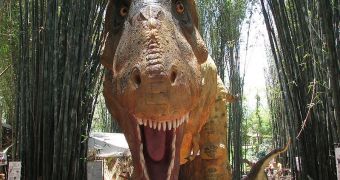If there were any doubts about whether Tyrannosaurus Rex was a hunter or a scavenger, the latest research carried out by scientists at the Zoological Society of London set things straight: T. Rex was no thief, it was one of the most ferocious hunters of its time.
This conclusion is based on the results of a very thorough analysis, of both the potential rivals and prey of the ancient carnivore.
On one side, for some, the teeth of the Tyrannosaurus Rex were proof that the beast was a true carnivore and a hunter, but on the other hand, some said, modern day lions steal prey from others – like antelopes killed by hyenas.
So the starting point of this research was to find out whether T. Rex hunted its food or stole it from others.
Those in favor of the thief theory, say that its puny arms were completely useless for haunting, and it also must have had a very sensitive nose, very helpful in tracking dead bodies.
Others, say that its teeth could only be those of a killer, being very resistant to impacts.
The researchers thought that the analysis of T. Rex's bones will lead them nowhere, so they focused on both the vegetarian victims and the smaller carnivores, which could have been the giant's competition.
Overall, they analyzed 18 herbivores – like the hard-headed pachycephalosaurs and the duck-billed hadrosaurs, and 10 carnivores – such as the Velociraptor and the two-legged Troodon.
It seems that almost half of all herbivore prey that T. Rex likely ate weighed between 55 and 85 kg (120 and 190 pounds).
Also, based on the abundance of small predators at the time, the researchers calculated that they could have covered 60 times more ground a day, that T. Rex.
This being said, these smaller carnivores would have quickly eaten the carcasses of smaller prey, leaving the giant with not much to eat.
And since large carcasses would have been very scarce at the time, T. Rex could not afford to be a scavenger and starve to death.
Lead researcher Chris Carbone, a carnivore ecologist at the Zoological Society of London, and his colleagues suggested that Tyrannosaurus Rex hunted mainly large prey, just like large mammalian predators do today.
He told LiveScience that “the costs of hunting for this species must have been high.
"Given this, did it act like so-called 'sit-and-wait' predators, first hiding, then the chase with a sudden burst of speed, and then the kill, like a lion?
“Or did it gradually chase them over long distances to the point of exhaustion like a wild dog?
“I suspect the former, but it would be interesting to develop arguments based on biomechanics and energetics to see if one option seems favored over the other."
“After the extinction of the dinosaurs, mammalian carnivores never exceeded a ton, as far as we know,” said Carbone.
“So the idea that T. Rex survived as a predator at about five to seven times the size of the largest mammalian predator means we need to learn more about how this species coped with its size and the fact that it was feeding on other large potentially rare dinosaur species.”
Understanding these extremely large predators could give new insight into the evolution of their behavior.
The findings are detailed online in the Proceedings of the Royal Society B.

 14 DAY TRIAL //
14 DAY TRIAL //